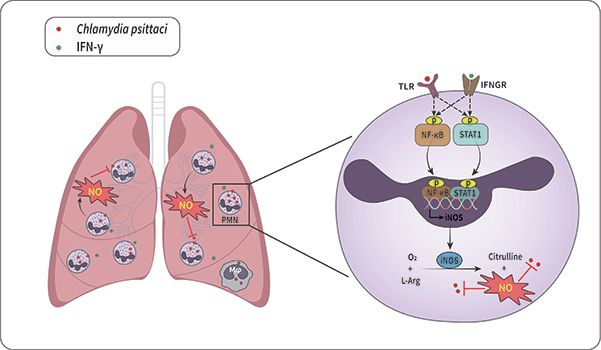Significance
Chlamydia psittaci, a gram-negative, intracellular pathogen, is recognized for its zoonotic potential and capacity to cause psittacosis disease. The pathogen can infect both human and birds which highlights the need to understand the host’s immune response mechanisms and develop more effective treatment strategy. Polymorphonuclear neutrophils (PMNs), commonly known as neutrophils, play a central role in the innate immune response, and considered the first line of defense against invading pathogens. They are traditionally associated with phagocytosis, the generation of reactive oxygen species, and the formation of neutrophil extracellular traps. However, their role in responding to Chlamydia psittaci infection, and nitric oxide (NO) production via inducible nitric oxide synthase (iNOS), has not been investigated. To this account, a new study published in Journal of Infectious Diseases and conducted by Ying Luo, Cui Wang, Zhaoxiang Du, Chuan Wang, Yimou Wu, and led by Professor Aihua Lei from the University of South China, the authors studied the role of PMNs in Chlamydia psittaci infection, specifically focusing on the production of NO through iNOS.
The team first established an animal model for studying the immune response to Chlamydia psittaci where BALB/c mice were intranasally infected with Chlamydia psittaci 6BC strain to mimic pulmonary infection. They monitored the progression of the infection and immune response over time and showed that infected mice have an increase in PMN numbers in lung tissues, which suggests an early immune response against the pathogen. To investigate whether PMNs produce NO via iNOS in response to Chlamydia psittaci infection, they used flow cytometry and immunofluorescence to identify PMNs and their iNOS expression and used as well qRT-PCR and western blot to quantify iNOS at the mRNA and protein levels, respectively. The researchers found a significant increase in iNOS expression and NO production in PMNs in the lungs of infected mice, which indicates that PMNs are a major source of NO during Chlamydia psittaci infection. To determine the effect of PMN depletion on the severity of Chlamydia psittaci infection, the authors, depleted PMNs using anti-Gr-1 antibodies and then they assessed the progression of infection and disease severity in PMN-depleted and control mice. They observed that depletion of PMNs resulted in aggravated infection and increased disease severity, highlighting the important protective role of NO-producing PMNs.
Moreover, studying the exact pharmacological mechanism involved, the authors identified the nuclear factor-κB (NF-κB) and signal transducer and activator of transcription 1 (STAT1) signaling pathways as essential for the induction of iNOS expression and subsequent NO production in PMNs. They used specific inhibitors (BAY 11-7082 for NF-κB and fludarabine for STAT1) and analyzed the phosphorylation status of signaling molecules to identify the signaling pathways responsible for iNOS induction in PMNs upon Chlamydia psittaci infection. This is in contrast to the mitogen-activated protein kinase (MAPK) pathways, which appear not to be involved in this specific immune response. The activation of NF-κB and STAT1 by Chlamydia psittaci infection highlights the complexity of the host-pathogen interaction and the regulatory mechanisms controlling the immune response. Moreover, identifying these critical signaling pathways in greater detail could inform the development of drugs that modulate these signaling pathways for therapeutic purposes. Additionally, the researchers performed in vitro assays where they treated PMNs with an iNOS inhibitor (L-NMMA) before being infected with Chlamydia psittaci to observe the impact on bacterial multiplication. They reported that inhibition of iNOS resulted in increased Chlamydia psittaci load, which confirms the notion that NO production by PMNs plays a vital role in controlling the infection.
The new study reported the important role of PMNs and the iNOS/NO axis in combating Chlamydia psittaci infection which opens new avenues for therapeutic intervention. For instance, therapies that enhance the function of PMNs or the production of NO could potentially improve outcomes in individuals infected with Chlamydia psittaci or similar pathogens. Moreover, the study suggests that enhancing iNOS activity in PMNs could be beneficial in treating infections. In conclusion, the work by Professor Aihua Lei and his team advance our knowledge on the immune defense mechanisms against Chlamydia psittaci and how iNOS/NO axis play significant role in chlamydial infections, therefore suggests potential therapeutic targets for enhancing host resistance to Chlamydia psittaci and possibly other pathogens.

Reference
Luo Y, Wang C, Du Z, Wang C, Wu Y, Lei A. Nitric Oxide-Producing Polymorphonuclear Neutrophils Confer Protection Against Chlamydia psittaci in Mouse Lung Infection. J Infect Dis. 2023;228(4):453-463. doi: 10.1093/infdis/jiad072.
 Medicine Innovates Medicine Innovates: Delivering innovations in medicine to the world for better health and prosperity
Medicine Innovates Medicine Innovates: Delivering innovations in medicine to the world for better health and prosperity

